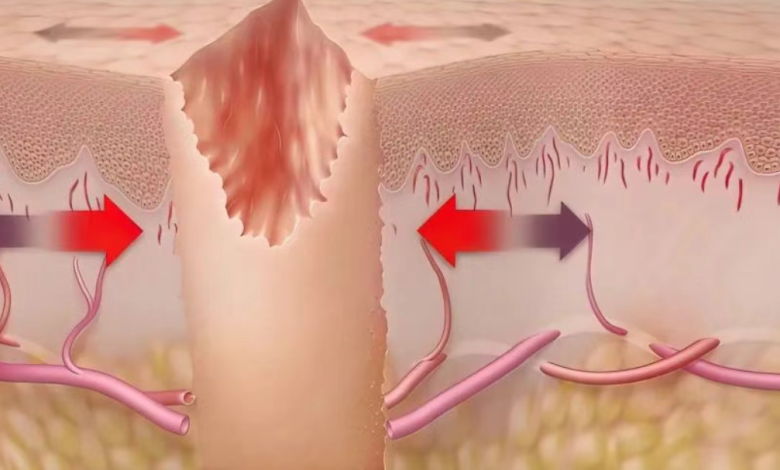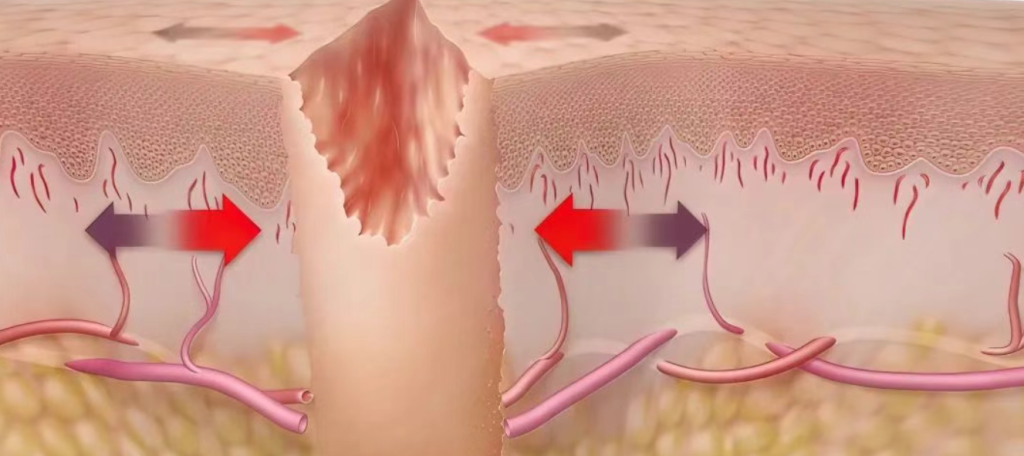How to Fade Acne and Surgical Scars Without Invasive Procedures: The Herbal Approach

Scars—especially those left by acne or surgery—can deeply impact a person’s confidence, social interactions, and even job prospects. While many turn to injections or laser treatments in search of smoother skin, not everyone is comfortable with invasive procedures due to cost, risk, or side effects. This raises a pressing question: Is there a safer, non-invasive way to fade scars effectively? The answer may lie in time-tested herbal remedies rooted in Traditional Chinese Medicine, offering a gentle yet powerful path to skin recovery.

1.Why Many People Avoid Invasive Scar Treatments
In recent years, an increasing number of people are turning away from invasive scar treatments such as laser therapy and surgery, and for good reason. One of the most common concerns is the risk of side effects, including hyperpigmentation (darkening of the skin) or secondary damage to the skin. These treatments can sometimes lead to further complications, making them an undesirable option for many.
Another major issue is the high cost associated with procedures like laser treatments, which are not only expensive but also often require multiple sessions to see noticeable results. In addition to the financial burden, the long recovery period can be inconvenient and uncomfortable, as patients may experience swelling, redness, or even scabbing in the weeks following treatment. For many, the long downtime and possible post-treatment care simply aren’t worth the potential results.
Furthermore, some invasive treatments, such as steroid injections, involve the use of hormonal drugs, which can lead to adverse side effects, including thinning skin, bruising, or even the potential for further scarring. These risks make many users hesitant to try these options.
As a result, there has been a noticeable shift towards natural therapies in recent years. People are increasingly seeking safer, non-invasive methods that offer long-term solutions without the risks associated with harsher treatments. Herbal remedies, with their gentle yet effective approach, have gained popularity due to their ability to naturally promote healing and skin regeneration without causing harm to the body.
2.Understanding the Nature of Acne and Surgical Scars
Acne and surgical scars develop through different mechanisms, but both share a common factor: they result from the skin’s response to injury or inflammation. Post-inflammatory hyperpigmentation occurs when the skin produces excess melanin as a result of inflammation, leaving behind dark spots after an acne breakout. On the other hand, hypertrophic scars form when the body overproduces collagen during the healing process, leading to raised, thickened scars. Additionally, atrophic scars, like those often seen from severe acne, appear as depressions or indentations in the skin where tissue loss has occurred.
For individuals who struggle with keloid scars, a more aggressive form of scar tissue formation, treatments can be more complex. Learn more about effective keloid treatment options at Keloid.
Understanding when to intervene in scar healing is crucial, and early intervention can make a significant difference. Treating scars during their proliferative phase—which typically occurs within the first 2 to 3 weeks after an injury or breakout—is vital. During this phase, the skin is still in the process of forming new tissue and collagen, and targeted treatments can help control and direct this process, preventing abnormal scarring.
This “window of opportunity” for scar treatment makes early-stage intervention far more effective than waiting until scars have fully matured. By addressing scars during the inflammatory and proliferative phases, one can reduce the formation of excessive tissue and pigmentation, leading to smoother, more even skin over time. Using treatments that target this critical phase can optimize healing and minimize the appearance of scars, providing a natural, effective solution without the need for invasive procedures.
3.The Power of Herbal Medicine in Scar Healing
Herbal medicine, particularly in Traditional Chinese Medicine (TCM), has long been recognized for its healing power, especially in scar treatment. The fundamental TCM principle of “activating blood and removing stasis” focuses on enhancing circulation and promoting the body’s natural healing processes. This theory emphasizes “restoring balance” rather than simply masking the issue, aiming to heal the skin from the inside out. By improving blood flow and dissolving blockages, TCM helps to prevent excessive collagen buildup, which can lead to raised or discolored scars.
Several key herbal ingredients play a critical role in scar healing. Sanqi (Panax Notoginseng), for example, is known for its anti-inflammatory and circulatory-enhancing properties, helping to reduce swelling and promote healing. Galla Chinensis (Five-Leaf Gall) acts as an astringent to reduce scar formation, while Licorice helps to soothe and balance inflammation. Borneol, a compound found in many TCM formulations, enhances the skin’s absorption of other healing ingredients, ensuring they reach deeper layers for maximum effect.
When compared to invasive procedures like laser treatments, herbal solutions offer a more gentle, non-invasive alternative. Laser therapies can sometimes irritate the skin, leading to further damage or secondary scarring. In contrast, herbal remedies avoid this risk by working naturally with the body’s processes, restoring balance without harsh interventions.
Furthermore, low-temperature fermentation technology has been used to enhance the efficacy of herbal treatments. This advanced method ensures that the active ingredients in herbs remain stable and are more easily absorbed by the skin, increasing the bioavailability and effectiveness of the treatment, making it a modern yet gentle solution for scar healing.
4.How to Use Herbal Scar Solutions Effectively at Home
To effectively use herbal scar solutions at home, timing, consistency, and proper technique are key. The optimal time to start using herbal scar treatments is within the first 24 hours after surgery or once acne lesions have healed and scabbed over. This is the critical window when the skin is still in the inflammatory phase and can benefit the most from active healing ingredients. Early intervention helps to prevent excessive collagen formation, which can lead to raised scars or dark spots.
For best results, apply the herbal solution regularly—usually three times a day—to ensure the active ingredients can work consistently. When applying, gently massage the area to improve blood circulation and promote better absorption. Massage also helps break down scar tissue and can assist in the softening and flattening of both new and old scars.
Herbal scar solutions are effective for both fresh wounds (such as post-surgical or recent trauma scars) and older scars (including acne or burn scars). For new wounds, focus on preventing the formation of raised scars by applying the product during the first 2-3 weeks when the scar is still in its proliferative phase. For older scars, you can apply the treatment over a longer period, up to 3-6 months, depending on the scar’s severity.
Precautions are essential to ensure the treatment’s success. Always keep the affected area clean and dry, and protect it from the sun by applying sunscreen regularly, as UV exposure can darken scars and delay healing. Lastly, remember that consistent use over time is key; natural herbal treatments work gradually, so patience and continued application will yield the best results.
5.Real Results: What to Expect and How Long It Takes
When using herbal scar treatments, patience is key—results typically take time to manifest, especially compared to quick-fix options like laser treatments. The timeline for seeing visible results can vary depending on the severity of the scar. For mild scars, such as minor acne marks or superficial cuts, users may start noticing improvements within 2 to 4 weeks of consistent application. For moderate scars, such as surgical scars or deeper acne scars, 3 to 6 months may be needed to see a noticeable reduction in size and discoloration. Severe scars, like hypertrophic or keloid scars, may take 6 months to a year to show significant improvement, but with continued use, the results can be long-lasting and stable.
Natural remedies require time to accumulate effects because they work by supporting the skin’s inherent healing processes, rather than masking the issue. This gradual healing process leads to more stable, long-term results compared to more invasive treatments, which may provide faster results but can also come with risks like scarring, side effects, or relapse.
A common misconception is that if results aren’t visible within a few days, the treatment isn’t working. However, herbal solutions need time to penetrate the skin and stimulate natural repair processes. Many users report significant improvements after consistent use for 6 to 8 weeks, so it’s important not to abandon treatment prematurely. Understanding this timeline helps set realistic expectations and ensures the treatment has adequate time to be effective.
In conclusion, herbal scar treatments offer a safe, non-invasive alternative to harsher methods, delivering effective results without the risks associated with surgery or laser treatments. By promoting the skin’s natural healing processes, these remedies provide a gentle yet powerful solution for scar reduction. If you’re looking for a reliable and proven method to heal scars, consider products like keloid, which combine centuries-old wisdom with modern technology to offer a safe, natural, and highly effective way to restore smooth, healthy skin. Choose a treatment that works with your body’s natural rhythm for lasting, beautiful results.





